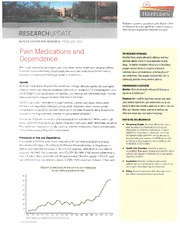
Research Update (2002 February): Pain Medications and Dependence PDF
Preview Research Update (2002 February): Pain Medications and Dependence
0• HazeLDeN Research Update is published bythe ButlerCenter for Researchto share significantscientificfindings from thefield ofaddictiontreatment research. RESEARCH U PDATE BUTLER CENTER FOR RESEARCH FEBRUARY 2002 Pain Medications and THEHAZELDEN EXPERIENCE Dependence Hazeldentreats peoplewithopioid addictionandtheir outcomesappearsimilartothosedependentonother drugs. In addition, Hazelden’sPhysicians-in-Residence When used responsibly, prescription pain medications reduce severe pain, allowingsufferers programteachesdoctorstorecognizeand assess to function more productisely. Unfortunately, the use of pain medications for non-medical substanceabuseand dependence, includingabuseof purposes is increasingand fuelingan epidemic ofaddiction. pain medications.This program increasestheirskill in addressingaddictionamong medical patients. Opioids Most pain medicationsare partofthe opioid class ofdrugs. Because opiates are used legally CONTROVERSIES&QUESTIONS to reduce severe pain, theyare sometimes referred to as analgesics,” a misleadingterm since Question: Whatshouldpeoplewithpainfulillnessesor notall analgesicsare opiate based (for example, non-steroidal anti inflamatory drugs). Opioids injuriesdotorelievepain? reduce pain by blocking pati receptors thattravel to the brain. Response:When usedforlegitimatepurposesand under Common opiold pain medications include morphine, codeine. oxycodone, hydrocodone close medicalsupervision, pain medicationscan bevery (Vicodin), and meperidine (Demerol), among others. OxyContin, which contains a high helpfultothosewhootherwisewould notbeabletofunction. concentration ofoxycodone, has been mentioned in the news frequently. Many abusers and When pain becomeschronic, alternativemethodscan suppliers ofthe drug have been arrested, including several physicians. effectivelyreducepain and restorefunctioning. Chronic use ofopioids can result in physical dependenceand addiction. When used in high HOWTO USETHIS INFORMATION doses, opioid pain medicationswill depress respiration and cause death. Withdrawal symptoms — RecoveringPeople: Befrankwith doctorsabout from opioid pain medications include insomnia, diarrhea, restlessness, muscleand bone pain, your recoveryfrom dependence andaskfor chills, nausea and vomiting, and muscle spasms. alternativestoaddicting medications. Ifopioid based pain medication Is necessary, minimize thedangersassociated with use bydiscussing Prevalence of Use and Dependence the issuewith yoursponsororAAINAgroupand The numberoffirst time users of pain medicationsfor non-medical purposes is growing by havinga close relativeorfriend dispensethe medication as prescribed. dramatically (see Figure). Accordingto the National Household Survey cii Drug Abuse, in 1969an estimated 265,000 people in the U.S. first used pain medicationsfor non-medical — Health Care Providers: Carefullyassessfor prescription drugabuseamongyour patrent. Refer purposes. By 1989, that numberwas up to 571,000. By 1999, it had jumped substantiallyto patientswith abuseordependencetoappropriate over 1.4 million. Most recentdata indicateapproximately2.8 million people in the U.S. used treatmentfacilities. pain medicationsfor non-medical purposes in 2000. Particularly high increases in new users — Counselors: Educatesubstance-dependent patientsabouthandlingfutureevents inwhichthe Numbers(inthousands)ofnewusers ofpain medications useofpain medication may be necessary. fornon-medicalpurposesbyyear. — Policy: Support lawmakers and otheragenciesin theireffortsto prevent prescriptionfraud. 1600 1400 1200 iuou ow 600 mu 200 1965 1967 1969 1971 1973 1975 1977 1979 1981 1983 1985 1987 1989 1971 1993 1995 1997 1999 SouRcE:SubstanceAbuseandOnntsiHealthSeru,.,sAdministrabon,2001.’ >CONTINUEDONBACK <CONTINUEDFROMFRONT Pain Medications and Dependence HazeLDeN have occurred amongyoung people ages 12 to 17. In 1985, this groupaccounted for 78,000 ofthe new users of pain medications. In 1999, that number had jumped to 722,000.° As the number offirst-time users has increased, sotoo (lasthe numberofadmissionsto References treatment centers for pain medication deperldence. Accordingto the Treatment Episode Data 1. FloridaDept.ofLawEnforcement.(2001).Overviewofprescription Set, which compiles information on admissions reported by U.S. states, the numberof people dregabuseandtheoxycodoneprotdnmisFloridalOn-linel.Available www.fdIn.atate.fLus. admitted to treatmentwho declared pain medications astheir primary drug ofabuse rosefrom 2. Thonrason,H.H.,&Dilts,S.L1199)1.Opivids.InB.i.Frances&S.I. 14,044 in 1994 to over 20,000 in 1999: Men and women were equally represented among Miller(Edo.),Clinicaltextbookofaddictivedisorders(pp.103-1201. NewYork:Guilford. admissions in 1999. The majoritywere Caucasian (85%) and their average age was 37. 3. SubstanceAbuseandMentalHealthServicesAdnvnislration.12001a(. Forty-four percent ofthem reported no other substances ofabuse otherthan the use of Sunirivaryoffindingsfronttire2000NationalHouse/mIdSurveyon Drvgdbuse,NHSDASeriesH-13.DHHSPeblicutionUs.ISMI01-2549. prescription painkillers. Rockuille,MD:Author.Available:www.samhsa.gov. 4. SubstanceAbuseandMental HealthServicesAdministration. (2001b(. TreatmentEpisodeDataSet(TEDS)1994-1999:National Deaths Attributed to Pain Medication Abuse admissionstosobstanceabovetreatmentservices(On-line). Available:www.samhsa.gov. Abuseof pain medicationscan be fatal. The Drug AbuseWarning Network reports annual data 5. SubstanceAbuseandMentalHealthServicesAdministration.(2000). from 139 medical examiners located in 40 metropolitan areas acrossthe US: Reported deaths Drug,lboseWarningNetyorkannualmedicalexaminerdata19911 (On-line).Available:www.samhsa.gov. are either drug-induced (any death caused directly bythe drug) ordrug-related (the drug 6. NIDA12001).NIDAnewsrelease:N/DOandpartnersannouncenational contributed to the death butwas notthe onlycause, e.g., car accident). Irl 1999, over 2000 initiativeonprescriptiondregnrisvseandabuse(On-line).Available: wecm.nida.nibgov. deathswere directly caused by pain medications, whether used singlyor in combination with . 7. Hatchinson,A.(December11,2001kStatementofAsaHutclrinson, otherdrugs: Pain niedication-related deaths numbered over600 in the sameyear. adnvvistratotDrugEnforcenrentAdministrationbeforetheHouse CommitteeonAppropriationsSvbconrnritteeonConrmerce,Justice, State,andJvdiciaiy)On-line).Available:c:wei.dea.gev/pubv/ testirnony.htm. What Is Being Done? 8. CenterforAddictionandSubstairceAbuse.(2000).Missed In response to growing problemswith prescription drugabuse, including pain medications, the opportunity:Nationalsurveyofprimna,ycarephysiciansavdpatients onsubstanceabove[On-line).Available:www.cusacolunibia.org. National Institute on Drug Abuse has partnered with several organizations to launch a national 9. NIDA.(2002).Prescriptiondrugs:Abuseandaddiction(On-line]. initiative on this topic. The main goals ofthe effortare to promote research and educate the Available:svmvw.nidu.rvh.gov. public, including health care providers, aboutthe misuseand abuse ofthese medications. 10. Stinclitield,B.,&Owen.P.119981.Hazelden’smodeloftreatmentand itsoutcome.AddictiveBehaviors,23,669-603. The Drug EnforcementAgency has also launched a plan to aggressivelytargetfraudulent 1). Loom,ER.etal.09991.Droolstamrdardizedpatientstoevaloate prescriptions, doctor shopping, and other illegal practices related specificallyto the abuse of thePhysiciansinResidenceProgram:Asubstanceabusetraining approach.JournalofAddictiveDiseases,18,39-50. OxyContin. 12. Compas,B.E.,Haaga,U.A.F.,Keefe,F.i..Leitenberg,H.,&F/illiavis, 0.A.1)9901.Sampliimgofenipiricallysuppvitedpsychological Effective prevention efforts are necessaryto combatthis growing problem. A recentsurvey treatmentstrainhealth psychology:Smoking.chronicpain,cancer, of primarycare physiciansacrossthe U.S. found less than one-third felt very prepared” andbulirnianervosa.JournalofConsultingandClinicalPsychology 66,89-112. to recognize prescription drugabuse amongtheir patients and over46% said theywere uncomfortable discussingthe issue. Clearly, educating physiciansto assessand diagnose this problem is necessary. Pharmacists are also in a unique position to prevent pain medication abuse and dependence. In addition to providingcleardirectionson appropriate use ofthese medications, theycan watch foraltered or forged prescriptions. In an effortto reduce prescription fraud, pharmacies have developed systemsto report illegal prescription activityto other pharmacies nearby. Summary While the growing numberof people abusing and dependent upon pain medications is disturbing, there is good news. Treatmentfor pain medication dependence is availableand effective. It is important to rememberthateach year pain medications are used appropriately by millions ofAmericanswith legitimate needs. Even so, given the consequences ofabuse and dependency on these drugs, keeping a closewatch on their use is essential. hazelden.org BUTLER CENTER FOR RESEARCH FEBRUARY 2002 The ButlerCenterfur Research informs arid irispruves recovery’servicesand producesresearch dat henefnv the kcld ofaddiction treatment.\1e\arededicated toconductingclinical research, collahor,itin\V1tii external researchers, intl cornmrinicatingscienrihc findings. PatriciaOwen.Ph.D..Diructor Ifyouhaveqeestions,orwouldliketorequestcopiesotResearchUpdate, pleasecall800-257-7800ext.4405,[email protected], orstrifeBC4,P.O.Boo11,CenterCity,MN 55012-0011. 2v..tu—:eV:esW,,’,,:.stor: cc”.z”.’I”.—5riejz:eJcoJsfnlIsgearer:g.ierod tiCP,-nU2l Found.it:an Ovi.24 (03/001
